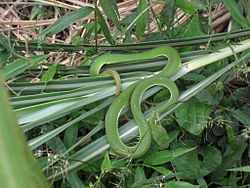タイワンアオハブ
| タイワンアオハブ | ||||||||||||||||||||||||||||||
|---|---|---|---|---|---|---|---|---|---|---|---|---|---|---|---|---|---|---|---|---|---|---|---|---|---|---|---|---|---|---|

| ||||||||||||||||||||||||||||||
| 保全状況評価[1] | ||||||||||||||||||||||||||||||
| LEAST CONCERN (IUCN Red List Ver.3.1 (2001)) 
| ||||||||||||||||||||||||||||||
| 分類 | ||||||||||||||||||||||||||||||
| ||||||||||||||||||||||||||||||
| 学名 | ||||||||||||||||||||||||||||||
| Trimeresurus stejnegeri Schmidt, 1925 | ||||||||||||||||||||||||||||||
| シノニム | ||||||||||||||||||||||||||||||
|
タイワンアオハブ Trimeresurus stejnegeri はマムシ亜科に属する毒蛇の一種。アジア熱帯域に分布する。
名称[編集]
種小名 stejnegeri はスミソニアン学術協会の爬虫類学者だったLeonhard Hess Stejnegerへの献名である。
英名としては、"bamboo viper"・"Chinese tree viper"[4]・"bamboo snake"・"Chinese green tree viper"・"Chinese bamboo viper"・"Stejneger's pit viper"・"Stejneger's palm viper"・"red tail snake"[5]・"Stejneger's bamboo pitviper"[6]などがある。台湾産個体は"Formosan bamboo viper"・"Taiwan green tree viper"とも呼ばれる[7]。
形態[編集]

最大で全長75cm、尾長14.5cmになる。雄の半陰茎は短く、分岐点よりも先まで棘を持つ[8]。
体鱗は体中央部で21列。上唇板は9-11で、吻端板と鼻板の間には継ぎ目がある。前眼鱗は単独で細く、横線が入ることがある。両前眼鱗間には11-16の鱗がある。腹板は150-174。尾下板は54-77個で対をなす[8]。
背面は明緑色から暗緑色、腹面は淡緑色から白。体側には上側が白、下側が橙から茶色(雌では白のみのこともある)の帯が走る。この帯は、体の最も外側の鱗列とその下の鱗列に位置する[8]。
生態[編集]
夜行性、半樹上性で、山地林の渓流周辺や水田に見られる。おそらくカエルが主食だが、小型哺乳類・鳥類・トカゲも食べる。産仔数は3-10[1]。
強力な出血毒を持つ。台湾ではアマガサヘビ、タイワンコブラ、ヒャッポダ、タイワンハブ、タイクサリヘビ(Daboia siamensis)と共に「台湾六大毒蛇」と呼ばれる[9]。
分布[編集]
アッサム州・ネパールからミャンマー・タイ王国・ラオス・中国南部・台湾に分布する[2][10]。Leviton et al. (2003) はベトナムにも分布するとしている[8]。基産地は当初「福建省邵武市」とされたが、その後Pope & Pope (1933) によって「福建省北西」と修正された[2]。
亜種[編集]
| 学名[11] | 記載者[11] | 英名[6] | 分布[6][10] |
|---|---|---|---|
| T. s. chenbihuii | Zhao, 1997 | Chen's bamboo pitviper | 海南島。吊羅山の標高225–290 m(陵水リー族自治県)と五指山の標高500 m(瓊中リー族ミャオ族自治県)で確認。 |
| T. s. stejnegeri | Schmidt, 1925 | Stejneger's bamboo pitviper | 甘粛省・四川省東部・貴州省・湖北省・湖南省・広東省・広西チワン族自治区・安徽省・福建省・浙江省・江蘇省・江西省・台湾・ベトナム |
| T. s. yunnanensis | Schmidt, 1925 | Yunnan bamboo pitviper | インド東部(西ベンガル州、メーガーラヤ州、アルナーチャル・プラデーシュ州、シッキム州)、ミャンマー |
脚注[編集]
- ^ a b Guo, P., Jiang, J., Lau, M.W.N. & Zhou, Z. (2012). "Trimeresurus stejnegeri". IUCN Red List of Threatened Species. Version 2014.3. International Union for Conservation of Nature.
- ^ a b c McDiarmid RW, Campbell JA, Touré T. 1999. Snake Species of the World: A Taxonomic and Geographic Reference, Volume 1. Herpetologists' League. 511 pp. ISBN 1-893777-00-6 (series). ISBN 1-893777-01-4 (volume).
- ^ The Reptile Database. www.reptile-database.org.
- ^ Mehrtens JM. 1987. Living Snakes of the World in Color. New York: Sterling Publishers. 480 pp. ISBN 0-8069-6460-X.
- ^ U.S. Navy. 1991. Poisonous Snakes of the World. US Govt. New York: Dover Publications Inc. 203 pp. ISBN 0-486-26629-X.
- ^ a b c Gumprecht A, Tillack F, Orlov NL, Captain A, Ryabov S. 2004. Asian Pitvipers. Geitje Books. Berlin. 1st Edition. 368 pp. ISBN 3-937975-00-4.
- ^ Brown JH. 1973. Toxicology and Pharmacology of Venoms from Poisonous Snakes. Springfield, Illinois: Charles C. Thomas. 184 pp. LCCCN 73-229. ISBN 0-398-02808-7.
- ^ a b c d Leviton AE, Wogan GOU, Koo MS, Zug GR, Lucas RS, Vindum JV. 2003. The Dangerously Venomous Snakes of Myanmar, Illustrated Checklist with Keys. Proc. Cal. Acad. Sci. 54 (24): 407-462.
- ^ 臺中榮民總醫院 (2011年7月20日). “(談臺灣的毒蛇咬傷的各種面貌與預防秘訣 ) 臺中榮總全球資訊網 Taichung Veterans General Hospital”. 臺中榮民總醫院 - 全球資訊網 (中文版). 2022年4月12日閲覧。
- ^ a b Malhotra, Anita, & Roger S. Thorpe (2004). “Maximizing information in systematic revisions: a combined molecular and morphological analysis of a cryptic green Pit Viper complex (Trimeresurus stejnegeri)”. Biological Journal of the Linnean Society 82 (2): 219. doi:10.1111/j.1095-8312.2004.00354.x.
- ^ a b "Trimeresurus stejnegeri" (英語). Integrated Taxonomic Information System. 2006年9月27日閲覧。
参考文献[編集]
- Creer, S.; Malhotra, A.; Thorpe, R.S.; Chou, W.H. 2001. Multiple causation of phylogeographical pattern as revealed by nested clade analysis of the bamboo viper (Trimeresurus stejnegeri) within Taiwan. Molecular Ecology 10 (8): 1967-1981.
- Parkinson, C.L. 1999. Molecular systematics and biogeographical history of Pit Vipers as determined by mitochondrial ribosomal DNA sequences. Copeia 1999 (3): 576-586.
- Peng, G. & Fuji, Z. 2001. Comparative studies on hemipenes of four species of Trimeresurus (sensu stricto) (Serpentes: Crotalinae). Amphibia-Reptilia 22 (1): 113-117.
- Schmidt, K.P. 1925. New Reptiles and a New Salamander from China. American Museum Novitates (157): 1-5. ("Trimeresurus stejnegeri, new species", p. 4.)
- Tu, M.-C. et al. 2000. Phylogeny, Taxonomy, and Biogeography of the Oriental Pit Vipers of the Genus Trimeresurus (Reptilia: Viperidae: Crotalinae): A Molecular Perspective. Zoological Science 17: 1147-1157.
外部リンク[編集]
- Trimeresurus stejnegeri at the Reptarium.cz Reptile Database. Accessed 19 December 2012.
- Trimeresurus stejnegeri[リンク切れ] at Uetz Lab. Accessed 27 September 2006.
